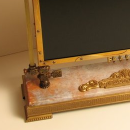Sweet Hacks Vol III – Steampunk, Vinyl, and More
Well this is the third edition of the sweet hacks series. In each edition I highlight clever code, cool uses of technology, and do it yourself projects that I find on the net. Anyone is welcome to submit their own sweet hacks by sending an email to jess@grokcode.com. Hacks are accepted for the series based on my whim.
 Steampunk Flat Panel Monitor
Steampunk Flat Panel Monitor
by Jake von Slatt
The Steampunk Monitor is a mod of a flat panel LCD. Jake gives the monitor a great psuedo-Victorian look with a faux marble base and detailed brass frame. This DIY project includes quite a bit of detail work, borrowing bits from gas lamps, grandfather clocks, kitchen cabinet knobs, and also contains a fair amount of custom fabrication work. The small pic to the left doesn’t really do the monitor much justice; click through to Steampunk to see better pics. Steampunk is well worth checking out anyway. It contains a ton on DIY projects in a similar style, all with great pictures and explanations of how everything was made. My favorites were the keyboard, motorbike, and Stratocaster guitar.
 Computer Games In Vinyl
Computer Games In Vinyl
by kempa.com
Kempa describes various computer games, messages, and art hidden by embedding data in vinyl records in the late 70s and early 80s. Most of them were made for the Sinclair Spectrum series of personal computers, which used a television for a monitor and loaded programs from tapes. To display the easter egg, the audio section that encoded the program was recorded from the LP to tape and then played in the Sinclair’s tape deck. Among the programs encoded this way are a game called “Flying Train” on Chris Sievey’s “Camouflage’ 7” single, “The Shaky Game” the goal of which is to drive a car to the center of a maze without getting eaten by bats off of a Shakin’ Stevens LP, and a message to “Hail Satan, lick his cloven hoof” from Scottish band Urusei Yatsura.
 The Quine Page
The Quine Page
by Gary P. Thompson II
A quine is a program that generates a copy of its own source text as its complete output. Gary has collected quines written in 55 different programming languages. To the left is a sample quine written in Lisp. Writing quines in language such as Lisp that can handle programs as data is much easier than writing them in languages like C that don’t have this capability built into the language. The quine page also contains a few polyglots, which are quines written in a combination of languages.
 Cats Tweet Videos When Eating
Cats Tweet Videos When Eating
by Wayne
Wayne describes how to setup a system that detects when your cat eats, then upload the video to a web server and tweet you the link. A great example of what can be done with linux, a webcam, some shell foo, and a bit of time. This sweet hack makes use of a program called Motion to do most of the heavy lifting, and uses simple shell scripts to copy the video to the web server and send out the tweet.
That’s it for this volume of sweet hacks. The next edition won’t be out for a while, so consider subscribing to the GrokCode feed or email updates to be notified when it comes out.



Discussion on
Sweet Hacks Vol III – Steampunk, Vinyl, and More
by Jess Johnson in Sweet Hacks
1 Comments
3:45 am UTC, 2008-12-03Leave a reply